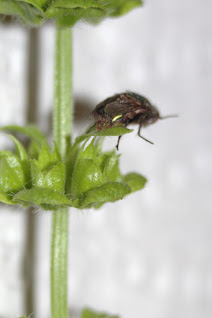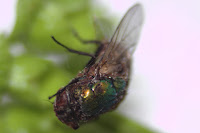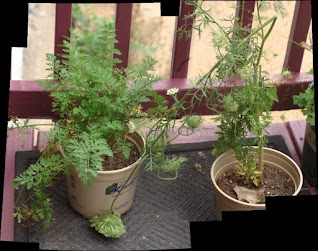 |
| Dead fly on basil. |
What he ended up pointing out was several house-flies that had become deceased while visiting floral structures on the various plants. Now, flies are dying all the time and they are often found feeding on flowers, so it wouldn't be surprising for them to die while at flowers. That these dead flies seemed to have a stubborn grip on the flowers they passed-on at made me consider an alternate model for their demise.
There are certain types of fungus that infect ants and take over the minds of the ants in the process, leading the ant to behave in a manner to help spread the fungus. Zombie ants. The zombie ants will clamp their jaws onto stems above where a colony of the host ant species has major highways, whereupon the fungus grows its spore-body and drops infectious spores on other unsuspecting ants. The ant-zombie-fungus in turn has its own parasite. This hyperparasite will help keep the zombie-fungus in check, thus supporting the health of the ant colonies. (Similar to the population dynamics between plankton and large fish.)
 |
| Closer. |
 |
| Even closer. |
It could easily be that dead flies, wherever they are, end up growing microbial colonies like this. It really isn't clear. To see if this is unusual, I'd have to collect a bunch of dead flies from different environments and determine what the normal decay process is for a fly cadaver. If ones like this are unusual, then I can imagine exposing lab-living flies to whatever is growing on the dead and seeing if they have altered behavior due to becoming a zombie.
References:
- Ants etc.:
- www.livescience.com/47751-zombie-fungus-picky-about-ant-brains.html
- news.psu.edu/story/323132/2014/08/18/research/zombie-ant-fungi-manipulate-hosts-die-doorstep-colony
- www.scientificamerican.com/article/zombie-ant-fungus-parasite/
- the-biologist-is-in.blogspot.ca/2016/08/interaction-networks.html
- Others insects:


